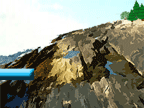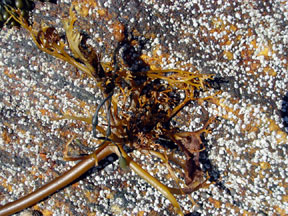 |
 |
|||||||||||||||
|
These plants are much larger and heavier than the other seaweeds we have discussed. Many of them prefer living in the high energy of exposed shorelines. So how do they hang on? The holdfast of kelp is a very unique structure. This elaborate structure resembles the root system of trees on land with many branches, intertwined with the substrate, as shown in the image above right. A common substrate for kelp is the horse mussel, Modiolus modiolus. A close relative of the blue mussel, the horse mussel is much larger (up to 6 inches in length) and lives in large beds in the subtidal area. The image above left shows a Laminaria spp. holdfast secured to a horse mussel. The horse mussel produces particularly strong, thick byssal threads and is firmly attached to the geologic substrate, preferring rocks and crevices. |
||||||||||||||||
Did you know... |
||||||||||||||||
|
||||||||||||||||



